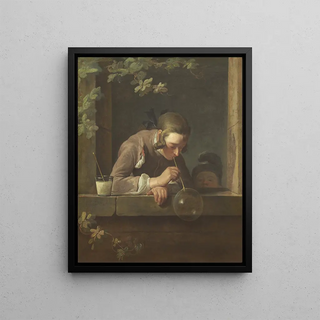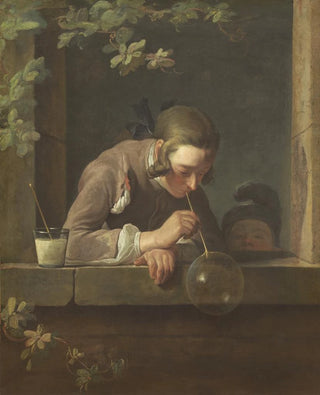Art print | Soap Bubbles - Jean Siméon Chardin


View from behind

Frame (optional)
In the world of art, some works transcend their era to become symbols of emotion and reflection. "Soap Bubbles," painted by Jean Siméon Chardin in the 18th century, is one of those creations that capture the fleeting beauty of childhood and simplicity. This painting, both delicate and poignant, transports us to a universe where the lightness of bubbles floating in the air evokes memories of carefree innocence. Through this artwork, Chardin invites us to appreciate the fleeting moments of life, to contemplate the beauty of simple things, while offering a glimpse of the technical virtuosity that characterizes his work.
Style and uniqueness of the work
Chardin's style is distinguished by his ability to blend realism and intimacy. In "Soap Bubbles," he manages to immortalize a scene of great tenderness, where light plays a crucial role. The iridescent reflections of the bubbles, rendered with remarkable precision, testify to the painter's mastery of light and color. Every detail, from the child's face to the translucent bubbles, is treated with meticulous attention, revealing Chardin's sensitivity to the fragility of existence. The composition, though simple, is charged with an emotional intensity that invites the viewer to deep contemplation. This painting is not just a visual representation; it evokes a sense of nostalgia, an invitation to remember the innocent pleasures of childhood.
The artist and his influence
Jean Siméon Chardin, an emblematic figure of the Rococo movement, established himself as one of the masters of French painting. His work is characterized by a realistic approach that highlights the humblest aspects of daily life. Chardin distanced himself from grandiose themes and idealized representations of his time to focus on more accessible subjects, often inspired by domestic life. His influence extends far beyond his era, inspiring generations of artists who sought to capture the authenticity of simple moments. By addressing universal themes such as childhood and nature, Chardin

Matte finish

View from behind

Frame (optional)
In the world of art, some works transcend their era to become symbols of emotion and reflection. "Soap Bubbles," painted by Jean Siméon Chardin in the 18th century, is one of those creations that capture the fleeting beauty of childhood and simplicity. This painting, both delicate and poignant, transports us to a universe where the lightness of bubbles floating in the air evokes memories of carefree innocence. Through this artwork, Chardin invites us to appreciate the fleeting moments of life, to contemplate the beauty of simple things, while offering a glimpse of the technical virtuosity that characterizes his work.
Style and uniqueness of the work
Chardin's style is distinguished by his ability to blend realism and intimacy. In "Soap Bubbles," he manages to immortalize a scene of great tenderness, where light plays a crucial role. The iridescent reflections of the bubbles, rendered with remarkable precision, testify to the painter's mastery of light and color. Every detail, from the child's face to the translucent bubbles, is treated with meticulous attention, revealing Chardin's sensitivity to the fragility of existence. The composition, though simple, is charged with an emotional intensity that invites the viewer to deep contemplation. This painting is not just a visual representation; it evokes a sense of nostalgia, an invitation to remember the innocent pleasures of childhood.
The artist and his influence
Jean Siméon Chardin, an emblematic figure of the Rococo movement, established himself as one of the masters of French painting. His work is characterized by a realistic approach that highlights the humblest aspects of daily life. Chardin distanced himself from grandiose themes and idealized representations of his time to focus on more accessible subjects, often inspired by domestic life. His influence extends far beyond his era, inspiring generations of artists who sought to capture the authenticity of simple moments. By addressing universal themes such as childhood and nature, Chardin






